
Gongora, abbreviated Gga in horticultural trade, is a member of the orchid family (Orchidaceae). It consists of 65 species known from Central America, Trinidad, and tropical South America, with most species found in Colombia. They grow across a wide geographical range, from wet forests at sea level, to mountainous regions in the Andes, as high as 1,800 m.

Cymbidium, commonly known as boat orchids, is a genus of evergreen flowering plants in the orchid family Orchidaceae. Orchids in this genus are epiphytic, lithophytic, terrestrial or rarely leafless saprophytic herbs usually with pseudobulbs. There are usually between three and twelve leaves arranged in two ranks on each pseudobulb or shoot and lasting for several years. From one to a large number of flowers are arranged on an unbranched flowering stem arising from the base of the pseudobulb. The sepals and petals are all free from and similar to each other. The labellum is significantly different from the other petals and the sepals and has three lobes. There are about fifty-five species and sixteen further natural hybrids occurring in the wild from tropical and subtropical Asia to Australia. Cymbidiums are well known in horticulture and many cultivars have been developed. The genome of Cymbidium mannii has been sequenced to study epiphytism and crassulacean acid metabolism.

Catasetum, abbreviated as Ctsm. in horticultural trade, is a genus of showy epiphytic Orchids, family Orchidaceae, subfamily Epidendroideae, tribe Cymbidieae, subtribe Catasetinae, with currently 200 accepted species, many of which are highly prized in horticulture.

Oncidium, abbreviated as Onc. in the horticultural trade, is a genus that, as of December 2023, contains about 340 species of orchids from the subtribe Oncidiinae of the orchid family Orchidaceae. It is distributed across tropical and subtropical America from Mexico, Central America and the West Indies to northern Argentina, with one species (O. ensatum) extending into Florida. Common names for plants in this genus include dancing-lady orchid and golden shower orchid.
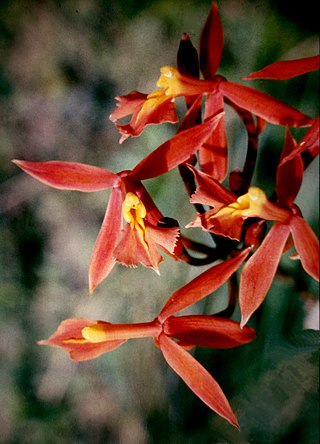
Epidendroideae is a subfamily of plants in the orchid family, Orchidaceae. Epidendroideae is larger than all the other orchid subfamilies together, comprising more than 15,000 species in 576 genera. Most epidendroid orchids are tropical epiphytes, typically with pseudobulbs. There are, however, some terrestrials such as Epipactis and even a few myco-heterotrophs, which are parasitic upon mycorrhizal fungi.

Ansellia is considered a monotypic genus of orchid, with only one species, Ansellia africana, commonly known as African ansellia or leopard orchid, however, it may in fact be a complex group of species which share common floral structure and growth habit.
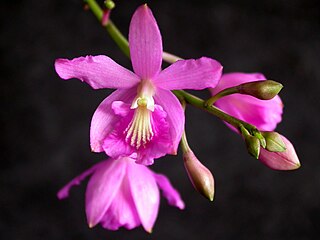
Pseudolaelia is a small genus belonging to the orchid family (Orchidaceae), the entire genus endemic to Brazil. The abbreviation used in the horticultural trade is Pdla.

Lycaste, abbreviated as Lyc. in horticultural trade, is a genus of orchids that contains about 30 species with egg-shaped pseudobulbs and thin, plicate (pleated) leaves.
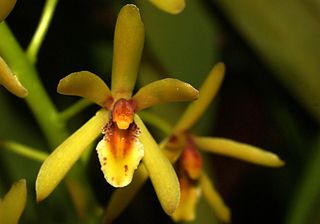
Cymbidium suave, commonly known as the snake orchid or grassy boat-lip orchid, is a plant in the orchid family and is endemic to eastern Australia. It is an epiphytic orchid that forms long-lasting clumps of grass-like leaves. Up to fifty crowded olive green to dark or brownish green flowers are borne on an arching flowering stem. Of the three Australian species of Cymbidium, this is the only one that does not have prominent pseudobulbs. It is found in eastern Australia, usually growing in the hollows of old or fallen, decaying trees.

Fascicularia is a monotypic genus of flowering plants in the pineapple family Bromeliaceae, subfamily Bromelioideae. The genus name is from the Latin fasciculus (bundle) and arius.

Baorangia bicolor, also known as the two-colored bolete or red and yellow bolete after its two-tone coloring scheme of red and yellow, is an edible fungus in the genus Baorangia. It inhabits most of eastern North America, primarily east of the Rocky Mountains and in season during the summer and fall months but can be found across the globe in China and Nepal. Its fruit body, the mushroom, is classed as medium or large in size, which helps distinguish it from the many similar appearing species that have a smaller stature. A deep blue/indigo bruising of the pore surface and a less dramatic bruising coloration change in the stem over a period of several minutes are identifying characteristics that distinguish it from the similar poisonous species Boletus sensibilis. There are two variations of this species, variety borealis and variety subreticulatus, and several other similar species of fungi are not poisonous.

Cymbidium madidum, commonly known as the giant boat-lip orchid, is a plant in the orchid family and is endemic to north-eastern Australia. It is a clump-forming epiphyte or lithophyte with crowded pseudobulbs, each with between four and eight flat, strap-shaped, thin leaves and up to seventy olive green flowers with the sepals and petals curving forwards. It is found in moist habitats in eastern Queensland and north-eastern New South Wales.

Coelogyne fimbriata is a species of orchid.

Cymbidium canaliculatum, commonly known as the channelled boat-lip orchid, tiger boat-lip orchid, native cymbidium or tiger orchid is a plant in the orchid family and is endemic to Australia. It is a clump-forming epiphyte with large, greyish green pseudobulbs, each with up to six curved, deeply channelled leaves and up to sixty fragrant, variably coloured flowers that often have spots and blotches and a white to cream-coloured labellum with red markings. This orchid usually grows in the forks or hollows of trees and is found from New South Wales to the northern parts of Western Australia.
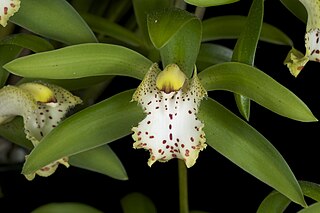
Cymbidium hookerianum is a species of orchid found in India, China, and Vietnam. It is distributed widely in Bhutan, especially in the cool temperate forests.

Cymbidium iridioides, commonly known as the Iris-Like Cymbidium is a species of boat orchid. It is a pseudobulbous epiphyte found from Himalaya to south-central China.
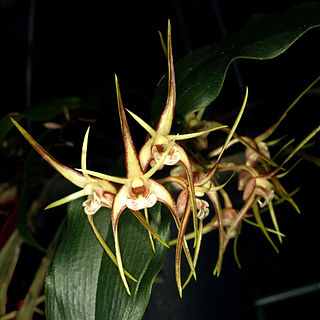
Dendrobium tetragonum, commonly known as the tree spider orchid, is a variable species of epiphytic or lithophytic orchid endemic to eastern Australia. Tree spider orchids are unusual in having pendulous pseudobulbs that are thin and wiry near the base then expand into a fleshy, four-sided upper section before tapering at the tip. There are only a few thin but leathery leaves at the end of the pseudobulbs and up to five flowers on relatively short flowering stems. To allow for the variations in the species there are five subspecies and a variety, some with a unique common name.

Leptotes bicolor is a species of orchid native to Paraguay and southern Brazil. It is the type species of the genus Leptotes. Its flowers and fruits are used as a substitute for vanilla in milk and ice cream.

Bulbophyllum arfakianum is a species of orchid in the genus Bulbophyllum. This rare orchid is endemic to Arfak Mountains at elevations 50~400 meters in rainforests, Papua New Guinea.

Pomatocalpa, commonly known as bladder orchids, or 鹿角兰属 , is a genus of about twenty five species from the orchid family, Orchidaceae. Plants in this genus are epiphytes or lithophytes with thick, leathery leaves and a large number of small flowers with a three-lobed labellum. There are about twenty five species found from tropical and subtropical Asia to the south-west Pacific.




















